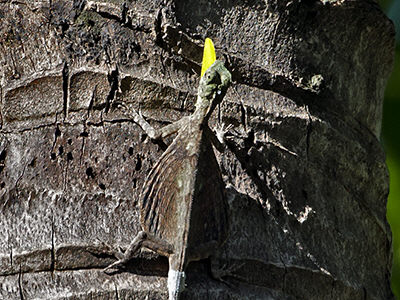
Fig 1

Fig 2

Fig 3

Fig 4

Fig 5
|
Family : AGAMIDAE
Species : Draco boschmai
Size (snout to vent) : up to 9 cm
Boschma's Gliding Lizard is a sun-loving species,
more typically found at forest edge or in disturbed habitats such as
agricultural areas or coastal districts.
The species was formerly considered to be a subspecies of Draco volans,
but is now elevated to species status (McGuire and Kiew, 2001).
Its patagium (wing membrane) is dark brown with lighter and darker
mottling. The gular flag of the male is triangular in shape, and bright
yellow in colour with darker mottling towards the base. The gular flag of
the female is small and bluish. The species exhibits significant variation
in colouration and patterning on different islands, however.
Draco boschmai reportedly has a somewhat longer tail than Draco
volans.
Its diet probably largely comprises ants, in common with many other species
of gliding lizard.
Draco boschmai occurs in the Nusa Tenggara (= Lesser Sunda) islands
of Indonesia, ranging from Lombok in the west, through Sumbawa, Komodo, Rintja,
Sumba and Adunara to Flores in the east, and to Sulawesi.
To the west of Lombok (i.e. Java and Bali), the species is replaced by the
closely-related Draco volans, and to the east of Flores (i.e. Timor
and other islands) the species is replaced by the closely-related Draco
timoriensis.
Figs 1 and 2 : Male with turquoise head, erect gular flag and partly
expanded patagium on a coastal coconut tree.
Fig 3 : Male on an inland coconut tree on the northern slope of Mount
Rinjani at 500 metres elevation.
Fig 4 : Pale female, with small bluish gular flag, on an inland coconut tree
on the northern slope of Mount Rinjani at 500 metres elevation.
Fig 5 : Another male specimen from Mount Rinjani at around 500 metres
elevation.
All images from the island of Lombok, Indonesia.
Reference :
McGuire, J. A., and Kiew, B. H., 2001. Phylogenetic systematics of Southeast
Asian flying lizards (Iguania: Agamidae: Draco) as inferred from
mitochondrial DNA sequence data. Biological Journal of the Linnean Society
72: 203–229. |